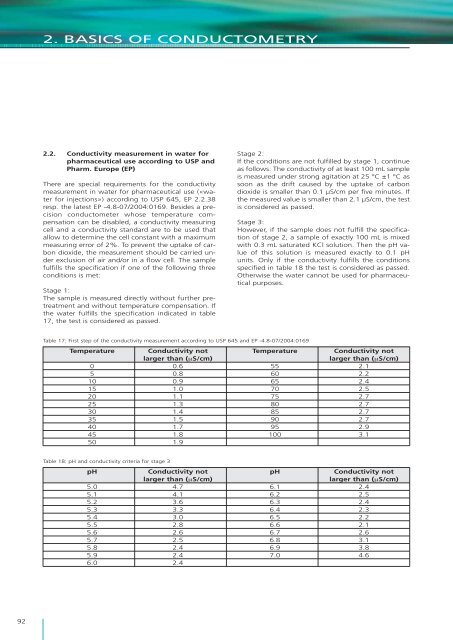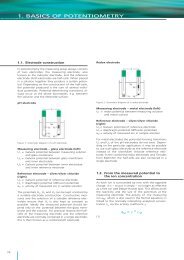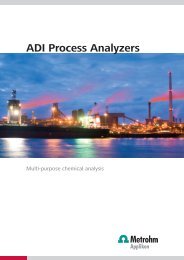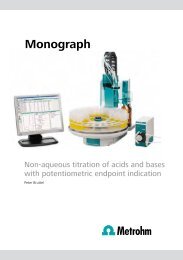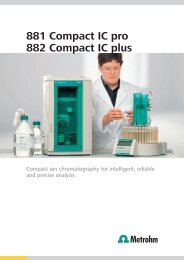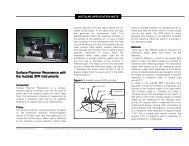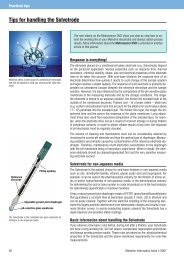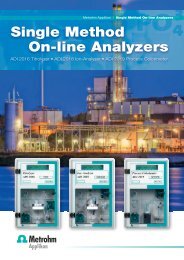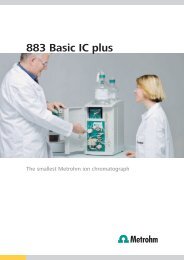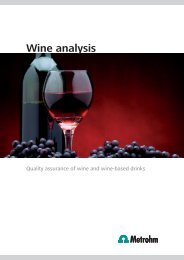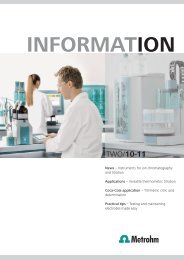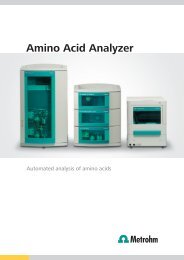What is the theoretical background of conductometry?
What is the theoretical background of conductometry?
What is the theoretical background of conductometry?
You also want an ePaper? Increase the reach of your titles
YUMPU automatically turns print PDFs into web optimized ePapers that Google loves.
2. BASICS OF CONDUCTOMETRY2.2. Conductivity measurement in water forpharmaceutical use according to USP andPharm. Europe (EP)There are special requirements for <strong>the</strong> conductivitymeasurement in water for pharmaceutical use («waterfor injections») according to USP 645, EP 2.2.38resp. <strong>the</strong> latest EP -4.8-07/2004:0169. Besides a prec<strong>is</strong>ionconductometer whose temperature compensationcan be d<strong>is</strong>abled, a conductivity measuringcell and a conductivity standard are to be used thatallow to determine <strong>the</strong> cell constant with a maximummeasuring error <strong>of</strong> 2%. To prevent <strong>the</strong> uptake <strong>of</strong> carbondioxide, <strong>the</strong> measurement should be carried underexclusion <strong>of</strong> air and/or in a flow cell. The samplefulfills <strong>the</strong> specification if one <strong>of</strong> <strong>the</strong> following threeconditions <strong>is</strong> met:Stage 1:The sample <strong>is</strong> measured directly without fur<strong>the</strong>r pretreatmentand without temperature compensation. If<strong>the</strong> water fulfills <strong>the</strong> specification indicated in table17, <strong>the</strong> test <strong>is</strong> considered as passed.Stage 2:If <strong>the</strong> conditions are not fulfilled by stage 1, continueas follows: The conductivity <strong>of</strong> at least 100 mL sample<strong>is</strong> measured under strong agitation at 25 °C ±1 °C assoon as <strong>the</strong> drift caused by <strong>the</strong> uptake <strong>of</strong> carbondioxide <strong>is</strong> smaller than 0.1 μS/cm per five minutes. If<strong>the</strong> measured value <strong>is</strong> smaller than 2.1 μS/cm, <strong>the</strong> test<strong>is</strong> considered as passed.Stage 3:However, if <strong>the</strong> sample does not fulfill <strong>the</strong> specification<strong>of</strong> stage 2, a sample <strong>of</strong> exactly 100 mL <strong>is</strong> mixedwith 0.3 mL saturated KCl solution. Then <strong>the</strong> pH value<strong>of</strong> th<strong>is</strong> solution <strong>is</strong> measured exactly to 0.1 pHunits. Only if <strong>the</strong> conductivity fulfills <strong>the</strong> conditionsspecified in table 18 <strong>the</strong> test <strong>is</strong> considered as passed.O<strong>the</strong>rw<strong>is</strong>e <strong>the</strong> water cannot be used for pharmaceuticalpurposes.Table 17: First step <strong>of</strong> <strong>the</strong> conductivity measurement according to USP 645 and EP -4.8-07/2004:0169Temperature Conductivity not Temperature Conductivity notlarger than (μS/cm)larger than (μS/cm)0 0.6 55 2.15 0.8 60 2.210 0.9 65 2.415 1.0 70 2.520 1.1 75 2.725 1.3 80 2.730 1.4 85 2.735 1.5 90 2.740 1.7 95 2.945 1.8 100 3.150 1.9Table 18: pH and conductivity criteria for stage 3pH Conductivity not pH Conductivity notlarger than (μS/cm)larger than (μS/cm)5.0 4.7 6.1 2.45.1 4.1 6.2 2.55.2 3.6 6.3 2.45.3 3.3 6.4 2.35.4 3.0 6.5 2.25.5 2.8 6.6 2.15.6 2.6 6.7 2.65.7 2.5 6.8 3.15.8 2.4 6.9 3.85.9 2.4 7.0 4.66.0 2.492


